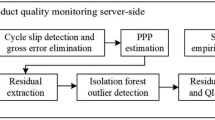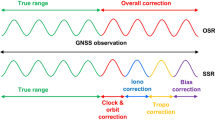Abstract
In order to meet the time-critical and high-precision positioning demands of massive market applications, real-time Precise Point Positioning (PPP) technology has been continuously developed and can achieve a high level of accuracy now. Beyond precision, it is also crucial to ensure the security and stability of real-time high-precision positioning services. Nevertheless, there are few studies that addressed the fault detection and exclusion (FDE) of real-time PPP correction service to protect users from potential faults in the GNSS satellites. This paper introduces a new real-time products quality monitoring method that could effectively identify the potential fault of GNSS satellite corrections using an unsupervised learning algorithm and provide means to alert the real-time PPP users. The ambiguity-fixed Un-differenced Carrier-phase Residual Statistics (UCRS) of large-scale regional stations are first constructed to reflect the status of satellite corrections accurately. A machine learning technique, known as Isolation Forest, is employed to identify outliers in the UCRS to detect situations of potential satellite faults. Then, the UCRS alarm factors are transmitted to users for PPP processing with a modified weighting scheme based on alert information. Experimental validation utilizing 30 monitoring stations in China demonstrates a detection success rate exceeding 95% for orbit faults larger than 5 cm and clock faults larger than 0.2 ns. It is also proved that this method can effectively identify orbit and clock jump in real-time GNSS products that cause additional positioning errors. With the alert information broadcasted by the server, the PPP after FDE (PPP-FDE) presents a significant accuracy improvement of 27–71% compared with traditional PPP processing.










Similar content being viewed by others
Data availability
The datasets supporting this research are available from the corresponding author for academic purposes on reasonable request.
References
Dow JM, Neilan RE, Rizos C (2009) The international GNSS service in a changing landscape of global navigation satellite systems. J Geodesy 83:191–198. https://doi.org/10.1007/s00190-009-0315-4
Du Y, Wang J, Rizos C, El-Mowafy A (2021) Vulnerabilities and integrity of precise point positioning for intelligent transport systems: overview and analysis. Satell Navig 2(1):1–22. https://doi.org/10.1186/s43020-020-00034-8
El-Mowafy A (2018) Real-time precise point positioning using orbit and clock corrections as quasi-observations for improved detection of faults. J Navig 71(4):769–787. https://doi.org/10.1017/S0373463317001023
European GNSS Agency (2019) PPP-RTK market and technology report
Geng J, Bock Y (2013) Triple-frequency GPS precise point positioning with rapid ambiguity resolution. J Geodesy 87(5):449–460. https://doi.org/10.1007/s00190-013-0619-2
Geng J, Guo J, Meng X, Gao K (2020) Speeding up PPP ambiguity resolution using triple-frequency GPS/BeiDou/Galileo/QZSS data. J Geod 94(1):6. https://doi.org/10.1007/s00190-019-01330-1
İlçi V, Peker AU (2022) The kinematic performance of real-time PPP services in challenging environment. Measurement 189:110434. https://doi.org/10.1016/j.measurement.2021.110434
Ji R, Jiang X, Chen X, Zhu H, Ge M, Frank N (2022) Quality monitoring of real-time GNSS precise positioning service system. Geo-Spatial Inf Sci 26(1):1–15. https://doi.org/10.1080/10095020.2022.2070554
Kouba J, Héroux P (2001) Precise point positioning using IGS orbit and clock products. GPS Solutions 5:12–28. https://doi.org/10.1007/PL00012883
Li X, Ge M, Douša J, Wickert J (2014) Real-time precise point positioning regional augmentation for large GPS reference networks. GPS Solutions 18:61–71. https://doi.org/10.1007/s10291-013-0310-3
Li X, Li X, Yuan Y, Zhang K, Zhang X, Wickert J (2018) Multi-GNSS phase delay estimation and PPP ambiguity resolution: GPS, BDS, GLONASS, Galileo. J Geod 92:579–608. https://doi.org/10.1007/s00190-017-1081-3
Li X, Li X, Liu G, Feng G, Yuan Y, Zhang K, Ren X (2019) Triple-frequency PPP ambiguity resolution with multi-constellation GNSS: BDS and Galileo. J Geod 93:1105–1122. https://doi.org/10.1007/s00190-019-01229-x
Li X, Han X, Li X, Liu G, Feng G, Wang B, Zheng H (2021) GREAT-UPD: an open-source software for uncalibrated phase delay estimation based on multi-GNSS and multi-frequency observations. GPS Solutions 25:1–9. https://doi.org/10.1007/s10291-020-01070-2
Li X, Gou H, Li X, Shen Z, Lyu H, Zhou Y, Wang H, Zhang Q (2023) Performance analysis of frequency-mixed PPP-RTK using low-cost GNSS chipset with different antenna configurations. Satellite Navig 4(1):26. https://doi.org/10.1186/s43020-023-00116-3
Liu FT, Ting KM, Zhou Z (2008) Isolation forest. In: 2008 Eighth IEEE International Conference on Data Mining, Pisa, Italy, 15–19 December 2008, pp 413–422. https://doi.org/10.1109/ICDM.2008.17
Malys S, Jensen PA (1990) Geodetic point positioning with GPS carrier beat phase data from the CASA UNO experiment. Geophys Res Lett 17(5):651–654
Wang Y, Li R (2013) The analysis of character of user range accuracy. In: Proceedings CSNC 2013, Lecture Notes in Electrical Engineering, Berlin, Heidelberg, p 244. https://doi.org/10.1007/978-3-642-37404-3_24
Wang Y, Shen J (2020) Real-time integrity monitoring for a wide area precise positioning system. Satell Navig 1(1):1–10. https://doi.org/10.1186/s43020-020-00018-8
Wang Y, Li R, Zhao R (2015) Research of signal-in-space integrity monitoring based on inter-satellite links. Chin J Electron 24(2):439–444. https://doi.org/10.1049/cje.2015.04.036
Weinbach U, Brandl M, Chen X, Landau H, Pastor F, Reussner N, Rodriguez-Solano C (2018) Integrity of the Trimble® CenterPoint RTX Correction Service. In: Proceedings ION GNSS+ 2018, Institute of Navigation, Miami, Florida, USA, September 24–28, 1902–1909. https://doi.org/10.33012/2018.15971
Zhang W, Wang J, El-Mowafy A, Rizos C (2023) Integrity monitoring scheme for undifferenced and uncombined multi-frequency multi-constellation PPP-RTK. GPS Solutions 27(2):68. https://doi.org/10.1007/s10291-022-01391-4
Zumberge J, Heflin M, Jefferson D, Watkins M, Webb F (1997) Precise point positioning for the efficient and robust analysis of GPS data from large networks. J Geophys Res: Solid Earth 102(B3):5005–5017. https://doi.org/10.1029/96JB03860
Acknowledgements
The algorithm implementation is based on the GNSS + REsearch, Application and Teaching (GREAT) software developed by the GREAT Group, School of Geodesy and Geomatics, Wuhan University. The numerical calculations in this paper have been done on the supercomputing system in the Supercomputing Center of Wuhan University.
Funding
This work has been supported by the National Natural Science Foundation of China (No. 41974027, 42204017) and the special fund of Hubei Luojia Laboratory (220100006).
Author information
Authors and Affiliations
Contributions
XXL, DL, and XL provided the initial idea and designed the experiments for this study; XXL, DL, and XL analyzed the data and wrote the manuscript; and JH, JW, and HG helped with the writing. All authors reviewed the manuscript.
Corresponding author
Ethics declarations
Competing interests
The authors declare no competing interests.
Ethical approval
This manuscript does not report on or involve the use of any animal or human data or tissue.
Consent for publication
All authors approved the final manuscript and the submission to this journal.
Additional information
Publisher's Note
Springer Nature remains neutral with regard to jurisdictional claims in published maps and institutional affiliations.
Rights and permissions
Springer Nature or its licensor (e.g. a society or other partner) holds exclusive rights to this article under a publishing agreement with the author(s) or other rightsholder(s); author self-archiving of the accepted manuscript version of this article is solely governed by the terms of such publishing agreement and applicable law.
About this article
Cite this article
Li, X., Liang, D., Li, X. et al. Quality monitoring of real-time PPP service using isolation forest-based residual anomaly detection. GPS Solut 28, 118 (2024). https://doi.org/10.1007/s10291-024-01657-z
Received:
Accepted:
Published:
DOI: https://doi.org/10.1007/s10291-024-01657-z




